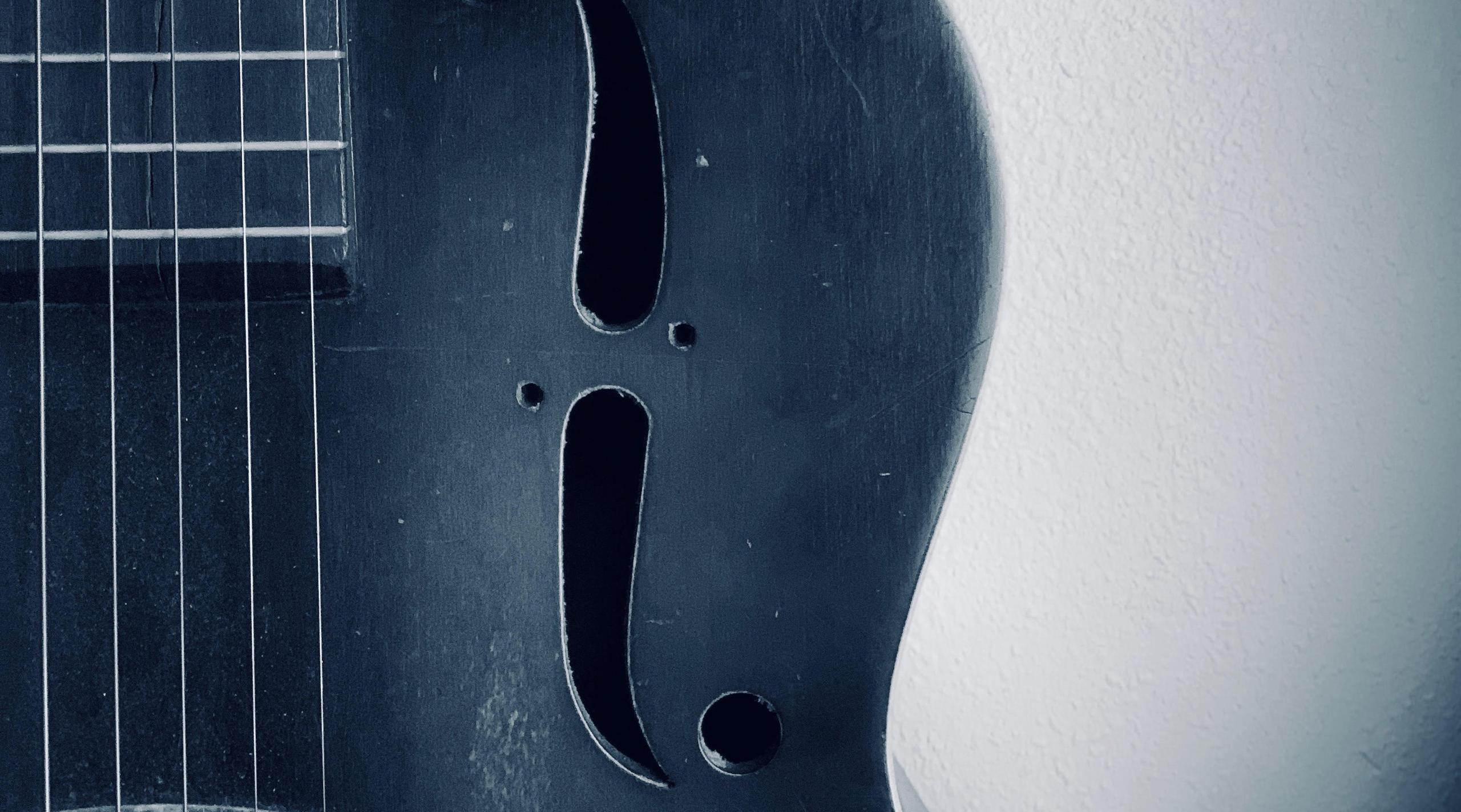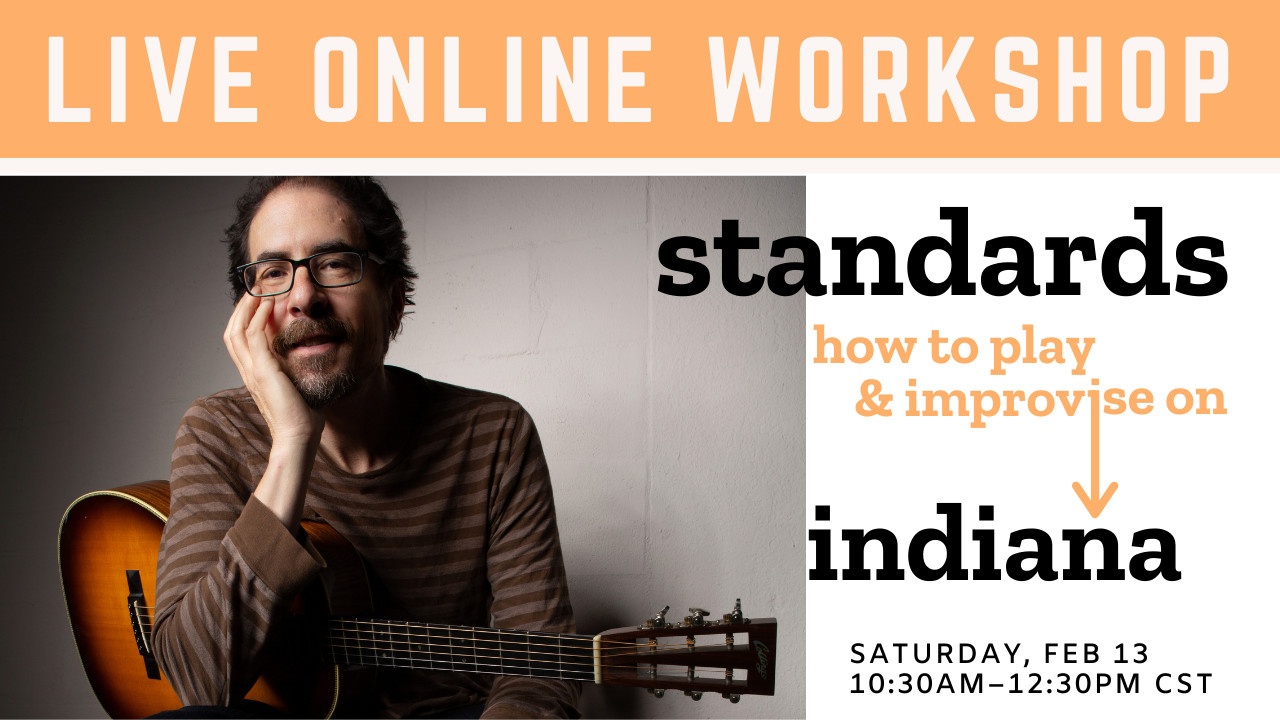Create improvised solos on a 32-bar standard from the Great American Songbook using a simple, stepwise approach! In this two-hour workshop, you'll learn:
- how to use the chord progression of a song to know what to play
- How to create phrases and licks to "play the changes"
- How to connect simple but effective ideas together to create coherent, musical solos of your own
...And how to do all this while fingerpicking in the key of C.
Register NowFingerstyle Standards
I love me a twelve bar shuffle or bluegrass classic as much as the next guy. But I've also been hearing standards my whole life, starting with the piano players in my family and, pretty soon afterwards, on the first Django Reinhardt and Charlie Christian records I got my hands on. And the moment I went from figuring out the chords to "Key To The Highway" to puzzling out songs like "Sweet Georgia Brown" or "Exactly Like You," I realized there was just more going on. More chords, more different kinds of chords, more keys to navigate (E flat? Seriously?), more bars, and, when the soloing started, clearly, more notes. It wasn't just I IV V anymore, and a single pentatonic scale wasn't going to cut it.
And yet, over time I discovered, there is common, guitaristic ground between standards and the blues, and if you pick your spots wisely, learning to fingerpick and improvise on standards doesn't have to feel like a completely different proposition from, say, a John Hurt song or a guitar rag. Choose the right song, put it in the right key, and the pieces start falling into place.
In this workshop, we'll take the song "Indiana" and play it in C with an alternating-thumb groove. We'll need the usual I, IV and V chords – C, F and G – plus the vi, A minor. Also a few ragtime-type moves like A7, D7 and E7. All familiar open position chords, nothing you wouldn't play on a blues or folk or pop song you already know. There are a couple of weirdo chords, those chords that always seem show up in the sheet music when you're trying to learn something more exotic. But only a couple: Fmin6 and F#dim. And amazingly enough, we can play those in open position, too.
Learning The Tune
When you sign up for the workshop, right away you'll get the tab to both a basic and a more advanced arrangement of the tune itself. It's a good idea to know how a tune is "supposed" to go before you start doing hip things with it, so the basic version shows you how to play the original melody of "Indiana" over the chords, in the alternating-thumb style. Then, the advanced version shows you the syncopated phrasing and chord voicings that reflect the way the people really play the tune.
Just understanding how to turn the basic facts of a song into something more musical and swinging is an essential step in learning to improvise, so we'll begin the workshop with an overview of these two arrangements. Then, we'll dive into the heart of the class: learning how to improvise on a fingerstyle arrangement of a standard.
Steps To Improvising
Next to music theory, improvising seems to be the most mysterious, voodoo-laden aspect of learning to play. Actually, let me rephrase that. Learning to improvise beyond the blues seems to be one of the most mysterious, voodoo-laden aspects of learning to play. And yet, you can use many of the same steps you used to learn blues, to figure out how to improvise on a standard.
1. Know the form: Twelve-bar blues makes sense because, well, it's twelve bars, and that's not hard to divide up into three four-bar lines. With a standard, you have thirty-two bars, but they divide up as well, into a series of eight-bar sections, each of which in turn can be seen as a pair of four-bar phrases. Knowing the form is the first step to playing solos that sound musical and have direction, because when your solos take the form into account, your playing reflects the idea of the song itself, not just a bunch of random notes.
2. Play licks that resolve: Blues licks tend to feel satisfying because of the way they land. When there's only one scale to think about, you can focus on your phrasing, that is, the shape and timing of your licks. On a standard, we'll need more than the pentatonic scale, but we can achieve the same sense of satisfaction by focusing on just a few bars at a time, working out variations that outline the progression on their way to landing the same way blues licks do.
3. Know your chord tones: And where are you going to land? That's where chord tones come in. Luckily, you don't need to learn your chord tones everywhere on the neck for every chord under the sun. For now, you just need to know the chord tones for the nine chords in "Indiana," on the top three strings. Again, we'll go phrase by phrase, just looking at a few chords a a time, to see how knowing the root, third and fifth of each chord (and maybe the seventh) can help you thread a cool, musical line through the progression.
A Linear, Repeatable Method
No two standards are exactly the same, but nearly any standard can be looked at this way: treating the form as a series of manageable phrases, learning how to play through the changes to those phrases, and building up a vocabulary of licks and variations. By looking in detail at one specific tune in this workshop, you'll take away a linear, repeatable method you can apply to any other standard you're interested in, along with a list of suggested tunes to try next.
Register NowWhy a live workshop? How does it work?
I've been doing in-depth live streams for over a year as part of my monthly membership, The Fingerstyle Five, and on my Youtube channel. I've had numerous requests to offer something about playing standards, but never felt like there was enough time and space to address that in either of those environments. The live stream format combines a concentrated amount of material on a specific topic with an interactive, Q&A situation that lets you get your specific questions answered while the class is still going on. During the workshop, you'll have a PDF of the essential exercises and diagrams, so you can focus on watching and learning, knowing the specifics are already in your hands. The whole two hours will be archived for later replay, so you'll be able to watch anything you want again for the next three months. And I'll pause at regular intervals to take questions via chat, to clear up aspects of the material that are still unclear.
Join The Interactive Live Stream This Saturday
Standards: How To Play And Improvise on "Indiana" is a two-hour live-online workshop being streamed this Saturday, February 13th at 10:30AM CST. Registration is $47 and the workshop will include:
- Two hours of live-streamed online instruction
- A downloadable PDF of essential concepts, examples and arrangements
- Live chat – ask David your questions as we work through the material
- Access to re-watch the archived live stream for the next three months


Can't attend live on February 13th? Yes, you can still register for the replay!
If you're not free this Saturday but still want access to the material, you can register just the same as you would to attend live, and watch the replay afterwards. You'll get the same PDFs, and the same three-month replay window. You can even submit a question ahead of time! Simply register below like you were going to attend, and watch at your own pace once you have the time.
Register Now

